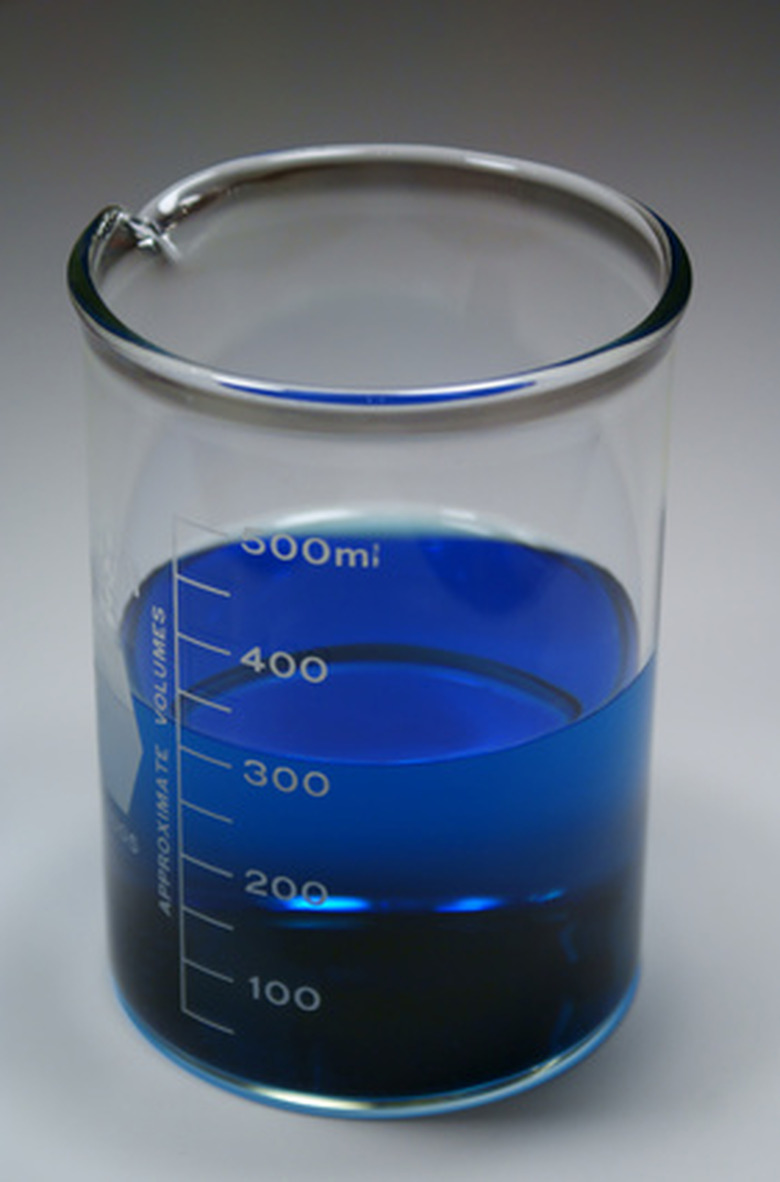How To Calculate Final Concentrations
Concentrations are a crucial concept in chemistry, and when you're combining solutions with different concentrations, you need to know how to calculate the final concentration. While you can use a dilution ratio calculator or something similar (see Resources) to find this out, it's much better to learn the math itself, so you can do it yourself with the calculator on your cell phone without the need for purpose-built tools.
Once you've picked up the key concepts underlying concentrations and learned a couple of simple formulas, you'll be able to handle any calculation you're likely to need in the lab.
Understanding Solutions
Understanding Solutions
A solution is a homogenous mixture of two substances, the solvent (e.g. water) and the solute (the thing you dissolve in the water), with "homogenous" just telling you that the two are thoroughly mixed.
The solution itself is the combination of these two components, so the volume of a solution tells you the total amount when the two have been combined. You need two pieces of information to fully quantify the concentration of a solution: the amount of solvent and the amount of solute (or the total amount of the solution).
The most general way to describe the concentration of solutions (i.e. how "strong" they are) is by dividing the amount of solute by the amount of the total solution, with both of these expressed in the same units. For example, if you add 30 ml of hydrochloric acid to 270 ml of water, you have a (30 ml / 300 ml) × 100 = 10 percent solution of hydrochloric acid in water. As a formula:
\(\text{Concentration (in percent)} = \frac{\text{Amount of solute}}{\text{Total amount of solution}} × 100\)
However, in chemistry, the concentration of solutions is often expressed as a "molarity" (a molar concentration), which is defined as the number of moles of solute divided by the number of liters of the solution. This gives you a value in moles per liter, where one mole of a substance is the equivalent of its atomic or molecular mass in grams.
Calculating Dilutions
Calculating Dilutions
If you start with a solution with a given molarity and then dilute it, you can use a simple formula to find the final concentration, or the volume you'll need to dilute it to in order to achieve a given concentration. The formula is:
\(M_i V_i = M_f V_f\)
Where M is the molarity, and V is the volume of the solution, with the subscripts i and f standing for "initial" and "final." So provided you know the molarity and volume you start with, and either the final molarity or volume you want, you can solve for the remaining quantity.
You find the value you want by dividing the left hand side (the product of the initial volume and molarity) by the value you know on the right. For example, if you have a 0.5 L solution of 2 M (i.e. a molarity of 2), and you want a solution with molarity 0.5 M, what final volume do you need?
Re-arrange to get:
\(V_f = \frac{M_i V_i}{M_f}\)
So:
\(\begin{aligned}\)
\(V_f &= \frac{2 \text{ M} × 0.5 \text{ L}}{0.5 \text{ M}}\)
\(&= 2 \text{ L}\)
\(\end{aligned}\)
You need to dilute the solution to 2 liters. To use this formula for other units (e.g. gallons), you just need to ensure that the concentration (i.e. the molarity) is expressed in the same unit as the volume, so you can use this as a dilution calculator in gallons if you express the concentration in moles per gallon.
Final Concentration Calculator in General
Final Concentration Calculator in General
If you need to calculate the final concentration for a more complicated situation, the easiest approach is to go back to the basic definition of concentration.
For example, if you're mixing two solutions with different concentrations, to find the final concentration you'll need the final amount of solute and the final amount of the whole solution. You can find this out if you work out the amount of solute in both original mixtures, add them together, and then divide by the total amount of solution. You can then multiply by 100 if you want it as a percentage.
For example, say you have a 2 percent solution (by mass) of salt in water, with 100 g of solution in total, and a 10 percent solution of salt in water with 150 g of solution in total.
The first solution contains 0.02 × 100 g = 2 g of salt, and the second solution contains 0.10 × 150 g = 15 g of salt. So in total you have 2 g + 15 g = 17 g of salt and 100 g + 150 g = 250 g of solution. This gives a 17 g / 250 g = 0.068 or 6.8 percent concentration final solution.
Cite This Article
MLA
Johnson, Lee. "How To Calculate Final Concentrations" sciencing.com, https://www.sciencing.com/calculate-final-concentrations-6949338/. 30 March 2020.
APA
Johnson, Lee. (2020, March 30). How To Calculate Final Concentrations. sciencing.com. Retrieved from https://www.sciencing.com/calculate-final-concentrations-6949338/
Chicago
Johnson, Lee. How To Calculate Final Concentrations last modified August 30, 2022. https://www.sciencing.com/calculate-final-concentrations-6949338/
